#maize exporters from India
Explore tagged Tumblr posts
Text
How Is Maize Export from India Shaping Global Markets?

What Is Maize Export from India?
Maize export from India refers to the international trade of maize, or corn, grown in India and supplied to various countries around the world. As a staple crop, maize is widely used in food products, animal feed, and industrial applications, making it a highly demanded commodity. Over the past decade, maize exporters from India have gained significant prominence in the global agricultural trade due to the quality, competitive pricing, and increasing demand for Indian maize. In this article, we will explore the role of maize export from India in global markets, examine maize export data, and understand how India compares with other maize exporting countries.
Why Is Maize Export from India Growing?
Maize export from India has been growing rapidly, driven by several key factors:
Rising Global Demand for Maize: Maize is one of the most versatile crops, used for food, livestock feed, and even biofuel production. The rising demand for maize worldwide has opened up new opportunities for India to become a significant supplier in global markets.
Favorable Climatic Conditions in India: India’s climate is well-suited for maize cultivation, especially in states like Karnataka, Bihar, Maharashtra, and Andhra Pradesh, allowing for large-scale production.
Competitive Pricing: Indian maize is competitively priced compared to other maize exporting countries, giving Indian maize exporters a strong foothold in international markets, particularly in regions like Southeast Asia, Africa, and the Middle East.
India’s growing role in the global maize market is supported by these factors, positioning the country as an important player in maize export.
What Does Maize Export Data from India Reveal?
Maize export data from India provides crucial insights into the scale and scope of the country’s maize trade. The data helps to highlight trends in export volumes, target markets, and economic contribution. Here are key observations from maize export data:
Export Volume and Value: India exports millions of tons of maize annually, with export volumes consistently rising due to increased demand from various countries. In recent years, maize exports from India have contributed significantly to the nation’s overall agricultural export revenue.
Top Export Destinations: According to maize export data, India’s main export destinations for maize include Vietnam, Malaysia, Indonesia, Bangladesh, and the Middle East. These countries rely on Indian maize for human consumption as well as animal feed.
Growth in New Markets: The data shows a gradual expansion into newer markets, particularly in African countries and regions where food security is a priority. This diversification is helping Indian maize exporters tap into emerging demand.
Maize export data underlines India’s role as a leading maize supplier in key international markets.
Who Are the Leading Maize Exporters from India?
Several prominent companies play a major role in India’s maize export sector. These maize exporters from India ensure that high-quality maize is produced, processed, and shipped to meet international standards. Some of the leading maize exporters from India include:
Adani Wilmar Ltd.: One of the largest agribusinesses in India, Adani Wilmar exports various agricultural products, including maize. The company is known for its extensive network and ability to meet global demand efficiently.
Olam Agro India Pvt. Ltd.: Olam is a global leader in agribusiness and food products, and its Indian subsidiary focuses on exporting maize and other grains to international markets, particularly in Southeast Asia and Africa.
Shree Sheela International: Specializing in exporting grains and cereals, including maize, Shree Sheela International is a significant player in India’s maize export industry. The company focuses on delivering high-quality maize to countries across Asia and Africa.
These maize exporters from India are instrumental in ensuring that the country’s maize reaches global markets, meeting both quantity and quality requirements.
How Does India Compare to Other Maize Exporting Countries?
India is one of the prominent maize exporting countries, but it faces competition from other major maize exporters globally. Here’s how India stacks up against the leading maize exporting countries:
United States: The U.S. is the largest maize exporter in the world, accounting for a significant share of global maize exports. The country benefits from advanced farming technologies and high yields, giving it an edge in terms of volume. However, India’s maize is often more competitively priced, making it attractive to price-sensitive markets.
Brazil: Brazil is another key player in the maize export market, with its high production capacity allowing it to supply maize to regions like Southeast Asia and Africa. Brazil competes directly with India in several markets.
Argentina: Argentina ranks among the top maize exporting countries, thanks to its large-scale production. Like Brazil, Argentina’s maize exports primarily serve the animal feed industry, making it a competitor to Indian maize in similar markets.
Although these countries dominate the maize export industry, India’s cost advantage and growing production capacity allow it to maintain a strong position in the global market.
What Are the Challenges Faced by Maize Exporters from India?
Despite the success of maize export from India, there are several challenges that maize exporters from India must address to remain competitive in the global market:
Price Fluctuations: Global maize prices are influenced by factors such as weather conditions, changes in demand, and geopolitical issues. Price volatility can affect the profitability of maize exporters and create uncertainties in trade.
Logistics and Infrastructure Issues: Efficient transportation and storage are essential for preserving the quality of maize during export. However, inadequate infrastructure, including cold storage and port facilities, can hinder the smooth export process.
Meeting International Standards: Exporters must ensure that their maize complies with the stringent safety and quality standards set by international markets. Factors like pesticide residues, moisture content, and non-GMO certification can impact export potential.
Addressing these challenges is essential for ensuring the continued growth of India maize export and maintaining a strong competitive position globally.
What Are the Opportunities for Growth in Maize Export from India?
Despite challenges, the maize export sector in India offers several growth opportunities that can further boost India’s position as a leading maize exporter:
Expansion into New Markets: While India already exports maize to key markets in Southeast Asia and the Middle East, there are opportunities to expand into new regions like Latin America and Europe, where demand for maize is growing. By diversifying its export markets, India can reduce reliance on specific regions and improve market stability.
Increased Demand for Organic Maize: With growing global demand for organic and non-GMO products, Indian maize exporters have an opportunity to tap into this niche market. By focusing on sustainable farming practices, Indian exporters can appeal to health-conscious consumers.
Value-Added Products: There is significant potential for maize exporters from India to venture into value-added products, such as maize flour, corn oil, and starch. These products have higher profit margins and are in demand in both developed and emerging markets.
By capitalizing on these growth opportunities, maize exporters from India can enhance their market share and improve profitability in global trade.
How Can Maize Exporters in India Stay Competitive?
To remain competitive in the global market, maize exporters from India must adopt several key strategies:
Investing in Technology: Implementing advanced farming and processing technologies can help improve maize yields and enhance product quality. Automation and precision farming techniques can also reduce production costs, making Indian maize more competitive in global markets.
Improving Infrastructure: Strengthening the export infrastructure, including logistics, storage, and transportation facilities, is crucial for ensuring timely and efficient delivery of maize shipments. Collaborating with the government to improve infrastructure can help address existing bottlenecks.
Focusing on Sustainability: With consumers and governments worldwide placing greater emphasis on sustainability, Indian maize exporters should prioritize environmentally friendly practices, such as using fewer chemical inputs and promoting organic farming.
These strategies will enable Indian maize exporters to stay competitive and thrive in an increasingly dynamic and challenging global market.
Conclusion: How Is Maize Export from India Shaping Global Markets?
Maize export from India is playing an increasingly important role in global agricultural trade. With rising demand for maize worldwide, Indian maize exporters are well-positioned to meet the needs of international markets. Maize export data highlights India’s growing presence in key regions such as Southeast Asia, Africa, and the Middle East. Despite challenges, such as price fluctuations and infrastructure issues, India continues to strengthen its position among top maize exporting countries by leveraging its competitive pricing and expanding market reach. With opportunities in organic maize and value-added products, the future of maize export from India looks promising, ensuring that the country remains a key player in the global maize market.
#maize export from india#maize exporters from india#Maize export data#maize exporters#maize exporting countries#India maize export
0 notes
Text
Discover the latest trends in maize exports from India and learn how exporters can capitalize on the growing demand for maize-based products in the global market.
#export#import#trade data#import data#export data#international trade#global trade data#import export data#trade market#maize exports from India#maize exporters from India#maize exporting countries#Maize export data#maize hs code#India maize export#maize exporters
0 notes
Text
Best Onion Export Company in India: A Comprehensive Guide
India is one of the largest producers of onions in the world, and its export market plays a crucial role in the global supply chain. With its fertile soil and favorable climate, India produces onions that are not only high in quality but also in demand across various countries. If you are looking for the best onion export company in India, this guide will help you understand what makes a company stand out in this competitive industry.
The Importance of Onion Exports from India
Onions are a staple in many cuisines around the world. Indian onions, known for their pungency and flavor, are particularly popular in countries across Asia, the Middle East, and Europe. The export of onions contributes significantly to India’s economy, with the country being one of the top exporters globally. The high demand for Indian onions is a testament to their quality, and this demand has led to the growth of numerous onion export companies in the country.
What to Look for in the Best Onion Export Company
When choosing an onion export company in India, several factors come into play:
Quality of Produce: The best companies prioritize the quality of their onions. They ensure that the produce is fresh, well-sorted, and free from any damage or disease. Quality control processes, such as grading and sorting, are essential to maintaining the high standards required for export.
Certifications and Compliance: A top-tier onion export company will have all the necessary certifications, such as APEDA (Agricultural and Processed Food Products Export Development Authority) registration, and comply with international food safety standards. These certifications ensure that the company adheres to the best practices in the industry.
Supply Chain Efficiency: Efficient logistics and supply chain management are crucial for the export of perishable goods like onions. The best companies have a streamlined process that ensures the onions reach their destination in optimal condition. This includes proper packaging, timely shipping, and efficient handling during transit.
Global Reach: The leading onion export companies in India have established networks in various countries. They have the experience and expertise to navigate international markets and meet the diverse demands of customers worldwide.
Customer Service: Excellent customer service is a hallmark of the best export companies. They provide timely communication, offer flexible solutions, and prioritize the satisfaction of their clients.
Top Onion Export Companies in India
Here are a few companies that have earned a reputation for being among the best onion exporters in India:
Mahindra Agribusiness: Known for its extensive agricultural expertise, Mahindra Agribusiness is a leading player in the onion export market. The company has a robust supply chain and is committed to delivering high-quality produce to international markets.
Jain Irrigation Systems Ltd.: Jain Irrigation is another major player in the onion export industry. With a strong focus on sustainability and innovation, the company ensures that its onions meet the highest quality standards.
Allanasons Private Limited: As one of India’s largest exporters of agricultural products, Allanasons has a strong presence in the onion export market. The company is known for its reliability, quality, and global reach.
S. R. International: S. R. International is a well-established name in the onion export business, offering a wide variety of onions to cater to different markets. Their focus on quality and customer satisfaction has made them a preferred choice for many international buyers.
Suminter India Organics: For those looking for organic onions, Suminter India Organics is a leading exporter in this niche market. The company’s commitment to organic farming and sustainable practices sets it apart in the industry.
Conclusion
Choosing the best onion export company in India requires careful consideration of factors such as quality, certifications, supply chain efficiency, global reach, and customer service. The companies listed above have demonstrated excellence in these areas, making them top contenders in the onion export market. Whether you are a buyer looking to source onions from India or a business seeking to partner with a reliable exporter, these companies are well-equipped to meet your needs.
India’s onion export industry continues to thrive, driven by the dedication of companies that prioritize quality and customer satisfaction. As global demand for Indian onions grows, the best export companies are poised to lead the way in delivering this essential ingredient to kitchens around the world.
0 notes
Text
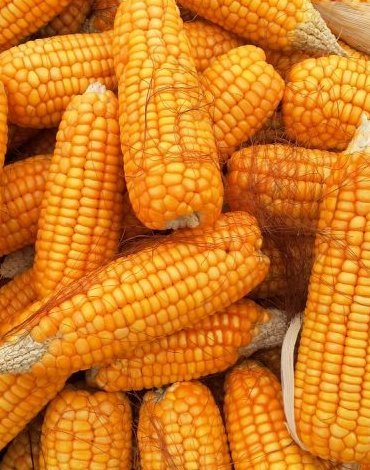
0 notes
Text
Maize Flour | Corn Flour Manufacturers, Exporters & Suppliers India. Shreeji Ingredients.
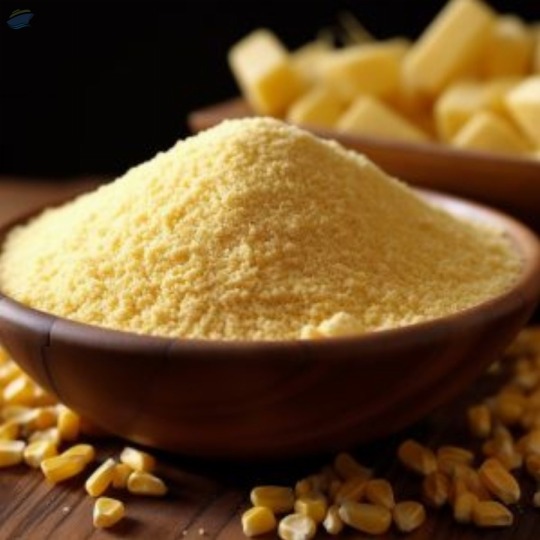
Introduction: Maize flour, also known as corn flour, is a staple ingredient that has been sustaining civilizations for centuries. Its significance in global cuisine spans from the Americas to Asia, offering a versatile canvas for culinary creativity. As one of India's leading manufacturers, exporters, and suppliers of maize flour, Shreeji Ingredients takes pride in providing a premium-quality product that unlocks a plethora of culinary possibilities. In this blog, we delve into the rich tapestry of maize flour, exploring its nutritional benefits, culinary applications, and its enduring presence in diverse cuisines worldwide.
Nutritional Profile: Maize flour is not only a culinary cornerstone but also a nutritional powerhouse. Rich in carbohydrates, dietary fiber, and essential vitamins and minerals, it serves as a wholesome foundation for various dishes. One cup of maize flour contains an array of nutrients, including manganese, phosphorus, magnesium, and B vitamins like thiamine and niacin. Its high fiber content promotes digestive health and helps regulate blood sugar levels, making it a favorable choice for those seeking balanced nutrition.
Culinary Applications: The versatility of maize flour knows no bounds, as it seamlessly integrates into a myriad of culinary creations. In Indian cuisine, maize flour takes center stage in iconic dishes like makki ki roti, a rustic flatbread enjoyed with sarson ka saag during winters. Its coarse texture lends a delightful crunch to snacks like makai pakoras and makai pattice, elevating the dining experience with every bite. Beyond traditional fare, maize flour transcends cultural boundaries, finding its way into global delicacies such as cornbread in the United States, arepas in Latin America, and tortillas in Mexico.
Gluten-Free Alternative: One of the most notable attributes of maize flour is its gluten-free nature, making it a viable option for individuals with gluten sensitivities or celiac disease. With the rising demand for gluten-free products, maize flour emerges as a versatile alternative in baking and cooking. From fluffy pancakes to delectable cookies, its light texture and mild flavor enhance a wide array of gluten-free recipes, ensuring that dietary restrictions never compromise on taste or quality.
Innovative Applications: The culinary landscape continually evolves, driven by innovation and experimentation. Maize flour serves as a blank canvas for culinary artists, inspiring innovative creations that push the boundaries of traditional cuisine. From maize flour pasta to artisanal corn tortilla chips, the possibilities are endless. Shreeji Ingredients empowers chefs and food manufacturers with premium maize flour, fostering culinary creativity and satisfying the evolving palate of consumers worldwide.
Sustainable Sourcing: At Shreeji Ingredients, sustainability lies at the heart of our operations. We prioritize ethical sourcing practices and sustainable agriculture to ensure the integrity of our products and the well-being of the environment. By partnering with local farmers and adhering to stringent quality standards, we uphold our commitment to delivering premium maize flour while promoting environmental stewardship and community empowerment.
Conclusion: Maize flour stands as a testament to the enduring legacy of a humble grain that has nourished generations across continents. From its nutritional prowess to its culinary versatility, it continues to captivate taste buds and inspire culinary innovation worldwide. As pioneers in maize flour manufacturing, exporting, and supplying, Shreeji Ingredients remains dedicated to upholding the rich heritage of this beloved ingredient while embracing the ever-evolving culinary landscape. Join us in celebrating the cornucopia of possibilities unlocked by maize flour, where every dish tells a story of tradition, creativity, and nourishment.
#Degerminated Corn Flour Manufacturers & Suppliers in India#Corn Flour in Indore - Manufacturers and Suppliers India#Corn Flour Manufacturers#Suppliers India - at Best Price#Buy Maize Flour (Corn Flour) at best price in India#Best Corn Flour Brands in India#Corn Flour At Best Price In India For Export And Suppliers#Corn Flour Distributors#Dealers & Dealership Price#Corn Flour (Maize Flour) - Get Latest Price & Mandi rates#Top Corn Flour Manufacturers in India#Yellow Corn Flour Manufacturer from Indore Madhya-Pradesh India#Maize Flour | Corn Flour Manufacturers & Suppliers India#Global Corn Flour Manufacturers & Suppliers List#Maize (Corn) Flour global top suppliers and manufacturers
0 notes
Text
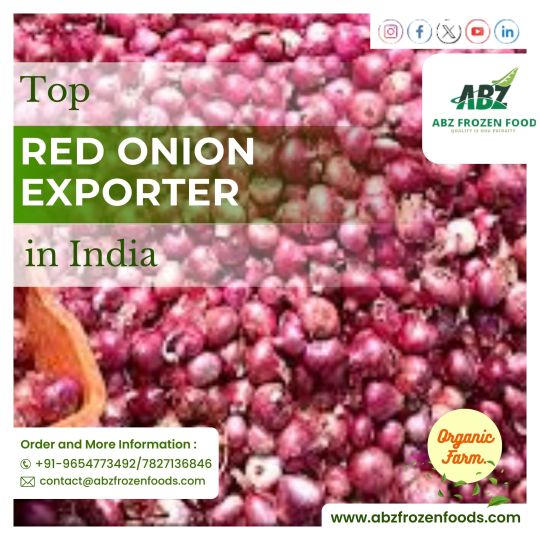
Top Red Onion Exporter in India
With their mitigating and cell reinforcement characteristics and the presence of flavonoids like quercetin, red onion can bring down the possibility creating constant ailment and a few sorts of disease. Our products are harvested with a reduced risk of heart disease since they have a high nutritional value and are low in cholesterol, saturated fat, and sodium.For more details please call +91-9654773492,7827136846 or visit our website https://abzfrozenfoods.com/red-onion-exporter.html
#Red Onion Exporter#Indian Buffalo Meat#Buffalo Meat Exporter#Buffalo meat exporter from India#Frozen Buffalo meat Exporters in India#Onion Exporter from India#Top Red Onion Exporter in India#Wheat flour Exporter#Yellow Maize Exporter#Green Millet Exporter#Semi Husk Coconut Exporter
0 notes
Text
The Export Process of yellow maize In India
Exporting yellow maize involves a systematic process that ensures the product's quality, compliance with international standards, and timely delivery. The following steps outline the typical journey of Indian yellow maize from farm to foreign markets:
1. Cultivation and Harvesting
Farmers cultivate yellow maize using advanced agricultural practices and technologies. Harvesting is typically done when the maize kernels reach optimum maturity. Post-harvest, the maize undergoes cleaning and drying processes to meet quality standards.

2. Quality Testing and Certification
Before export, the maize undergoes rigorous quality testing. Various parameters, including moisture content, aflatoxin levels, and pesticide residues, are assessed to ensure compliance with international standards. Once the maize passes these tests, it is certified for export.
3. Packaging
Proper packaging is crucial for preserving the quality of yellow maize during transportation. The maize is usually packaged in jute or polypropylene bags, clearly labeled with information such as batch number, date of packing, and net weight.
4. Logistics and Transportation
Efficient logistics play a crucial role in the export process. Yellow maize is transported from farms to ports using a well-established network of roads and railways. At the ports, the maize is loaded onto containers for shipment to international markets.
5. Customs Clearance and Documentation
Exporting yellow maize requires compliance with customs regulations and documentation. This includes providing the necessary certificates, such as the phytosanitary certificate and certificate of origin, to meet the import requirements of destination countries.
6. Global Market Reach
Indian yellow maize finds its way to various international markets, including but not limited to countries in the Middle East, Southeast Asia, Africa, and Europe. Establishing and maintaining strong trade relationships with importing nations is crucial for sustaining and expanding market reach.
0 notes
Text
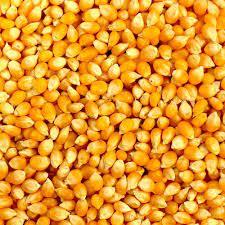
Yellow Maize Exporter from Bangalore | Maize Trader in Bangalore, India
0 notes
Text
Dried White Maize Exporters in Ahmedabad, Gujarat | Dried Yellow maize exports from India | Yellow Maize supplier from Gujarat, India

Our Company Shivay Export deals in Maize. We are directly Yellow Maize supplier. Dried Yellow maize offered by us have high self-life than other varieties from India
#Dried Yellow maize exports from India#Yellow Maize supplier from Gujarat#India#Dried White Maize Exporters in Ahmedabad#Gujarat
0 notes
Text
The standard legend of India’s Green Revolution centers on two propositions. First, India faced a food crisis, with farms mired in tradition and unable to feed an exploding population; and second, Borlaug’s wheat seeds led to record harvests from 1968 on, replacing import dependence with food self-sufficiency.
Recent research shows that both claims are false.
India was importing wheat in the 1960s because of policy decisions, not overpopulation. After the nation achieved independence in 1947, Prime Minister Jawaharlal Nehru prioritized developing heavy industry. U.S. advisers encouraged this strategy and offered to provide India with surplus grain, which India accepted as cheap food for urban workers.
Meanwhile, the government urged Indian farmers to grow nonfood export crops to earn foreign currency. They switched millions of acres from rice to jute production, and by the mid-1960s India was exporting agricultural products.
Borlaug’s miracle seeds were not inherently more productive than many Indian wheat varieties. Rather, they just responded more effectively to high doses of chemical fertilizer. But while India had abundant manure from its cows, it produced almost no chemical fertilizer. It had to start spending heavily to import and subsidize fertilizer.
India did see a wheat boom after 1967, but there is evidence that this expensive new input-intensive approach was not the main cause. Rather, the Indian government established a new policy of paying higher prices for wheat. Unsurprisingly, Indian farmers planted more wheat and less of other crops.
Once India’s 1965-67 drought ended and the Green Revolution began, wheat production sped up, while production trends in other crops like rice, maize and pulses slowed down. Net food grain production, which was much more crucial than wheat production alone, actually resumed at the same growth rate as before.
But grain production became more erratic, forcing India to resume importing food by the mid-1970s. India also became dramatically more dependent on chemical fertilizer.
According to data from Indian economic and agricultural organizations, on the eve of the Green Revolution in 1965, Indian farmers needed 17 pounds (8 kilograms) of fertilizer to grow an average ton of food. By 1980, it took 96 pounds (44 kilograms). So, India replaced imports of wheat, which were virtually free food aid, with imports of fossil fuel-based fertilizer, paid for with precious international currency.
Today, India remains the world’s second-highest fertilizer importer, spending US$17.3 billion in 2022. Perversely, Green Revolution boosters call this extreme and expensive dependence “self-sufficiency.”
108 notes
·
View notes
Text


People
Hunger Has Natural Causes, Right?
Despite the fact that the world produces 1.5 times as much food as is needed to feed the human population, starvation and famine are endemic to modern capitalism. 900 million people die from starvation each year, but there is no global shortage of land to grow food. The UN estimates that there is enough land to feed a world population of 14 billion people. But what is it being used for? As in the ‘developed’ North, large landowners control the vast majority of land. In 83 countries, 3% of farmers control 79% of farmland, much of it left unused in order to maintain profits. Big Food made over $7bn profit from the South in 1990, and probably far more through transfer payments. It uses its economic power to force down the prices of rice, coffee, sugar, cocoa and cotton. Average prices in 1989 were 20% down on those of 1980. This led to an increase in foreign debt for Southern countries, with consequent increased economic hardship for the poor majority (higher taxes, inflation, etc.). Brazil has an area of farmland the size of India left uncultivated while 20 million rural poor are landless; the richest 1% owns 15 times as much land as the poorest 56% of Brazilian farmers. In Guatemala, 2% of landowners own 66% of the land. In the Philippines agribusiness producing sugar, cotton and pineapples for export has pushed 12 million peasants into the lowland forests.
Drought in Africa is part of a millennia-long cycle that human societies adapted to. It is cash crop exploitation, the market economy and taxation that produce starvation, not drought. During the 1970s, when famines first began to be reported regularly, ships that brought relief supplies to the port of Dakar left carrying peanuts, cotton, vegetables, and meat. In Bangladesh, often cited as the model for the Malthusian argument, 90% of the land is worked by sharecroppers and labourers. Many starved after the 1974 floods, while hoarders held on to four million tons of rice. In the mid-80’s severe famines occurred in the Sahel countries of Burkina Faso, Mali, Niger, Senegal and Chad yet during the same period record harvests of cotton were exported to the industrial centres of the world.
Cash crops go to feed the global supermarket, yielding higher profits for international capital and accelerating global industrialisation. Mexican soil and labour supplies almost 70% of the US market for much winter and early spring vegetables. The result is that agriculture for local consumption is squeezed out and the prices of staple foods rise. Up to 50% of total meat production in Central America is exported, mainly to North America. The “Green Revolution” of the 1970s and 1980s, that the ruling class said would feed the hungry, has in fact only supplied the global supermarket. The same will certainly be true of the ‘wonder crops’ of the GM revolution. The corporate claims that GM and industrial food production in general will ‘feed the world’ are straightforward lies. The maize/soya/ animal product system they are pushing so heavily is not a rational way to produce food — an acre of cereal is estimated to produce 5 times as much protein as one devoted to meat production, an acre of legumes (beans, peas, lentils) 10 times as much and an acre of leafy vegetables 15 times as much.
#hunger#humans#world hunger#classism#ecology#climate crisis#anarchism#resistance#community building#practical anarchy#practical anarchism#anarchist society#practical#revolution#daily posts#communism#anti capitalist#anti capitalism#late stage capitalism#organization#grassroots#grass roots#anarchists#libraries#leftism#social issues#economy#economics#climate change#climate
6 notes
·
View notes
Text
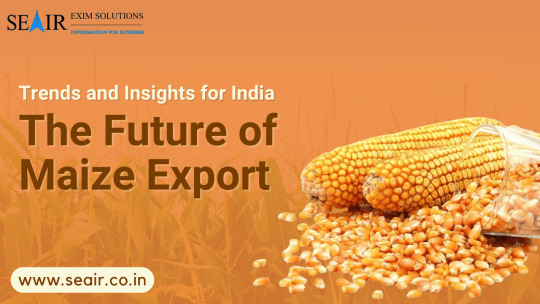
Maize is an important crop in India, functioning as both a staple food and a source of biofuel, providing food security and supporting industrial demands. This blog delves into India's maize exports, covering export statistics, HS codes, and exporters. Explore Blog: "The Future of Maize Export: Trends and Insights for India"
#maize exports from India#maize exporters from India#maize#Maize export data#maize exporters#maize exporting countries#maize hs code#maize production in India#largest producer of maize in India#India maize export#maize cultivation in India#maize importing countries from India#import#export#import export data#global trade data#international trade#trade data#trade market
0 notes
Text
Trade
We come now to the trade of the province, concerning which my remarks refer mainly to the three cities of Kashgar, Yarkand and Khotan. Kashgar, the residence of the Governor, is not only the chief town, but the centre of Russian trade. Owing to its favoured position with regard to the railway at Andijan and the wealth of its rich oasis, the city is increasing in population, which is now estimated at 80,000. Land is rising in price and there is hardly a vacant house. Yarkand, with 70,000 inhabitants, is also rich and prosperous, but in a less marked[Pg 246] degree, and is the chief centre of the trade with India. Khotan, with a population of 50,000, is the centre of the manufacturing activity of the province, being celebrated for its jade, silk and carpets.
The mainstay of the export trade with India is the drug known as charas in India, prepared from the hemp which is planted round the fields of maize; raw silk is the next most valuable export. The chief articles of import from India are muslins, longcloths, and red cotton prints; while spices from Southern India are in great and increasing demand, and penetrate even to the western provinces of China. Surat brocades are imported for covering caps and for women’s cloaks, and I have seen some good specimens of the beautiful cloth of gold.

4 notes
·
View notes
Text
0 notes
Text
Broken Maize - Manufacturer Exporter Supplier in India: Shreeji Ingredients
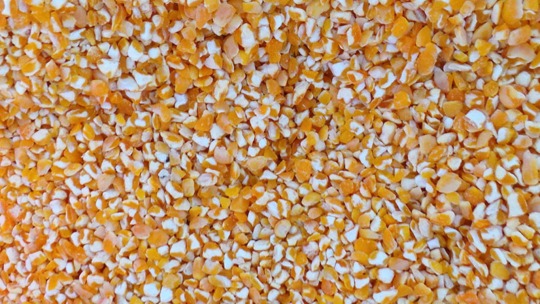
In the realm of livestock nutrition, sourcing high-quality feed ingredients is paramount to ensuring the health and productivity of animals. Broken maize, also known as broken corn, emerges as a notable contender in providing essential nutrients to cattle and poultry. As a leading manufacturer, exporter, and supplier of broken maize in India, Shreeji Ingredients takes pride in offering premium-grade broken maize to meet the diverse needs of the agricultural sector. In this blog post, we delve into the myriad benefits of broken maize and why it stands out as a preferred feed option for livestock.
Understanding Broken Maize
Broken maize refers to maize kernels that have been fractured or broken into smaller pieces. While the term "broken" may imply a flaw, in the context of animal feed, it presents numerous advantages. Broken maize is obtained during the milling process and can vary in size and texture, making it suitable for various applications in livestock feed formulations.
Nutrient-Rich Composition
Despite its fragmented appearance, broken maize retains its nutritional value, offering a rich source of carbohydrates, proteins, fiber, and essential vitamins and minerals. This nutrient-dense composition makes it an ideal component in formulating balanced diets for cattle, poultry, and other livestock.
Enhanced Digestibility
One of the key advantages of broken maize lies in its enhanced digestibility. The smaller particle size facilitates easier digestion and absorption of nutrients by animals, leading to improved feed conversion rates and overall growth performance. This aspect is particularly beneficial for young animals and those with sensitive digestive systems.
Economical Feed Option
Broken maize presents a cost-effective alternative to whole maize kernels, making it an attractive choice for livestock farmers looking to optimize feed costs without compromising on quality. Its affordability, coupled with its nutritional value, allows farmers to formulate nutritious diets while staying within budget constraints.
Versatile Application
Broken maize finds versatile application across various segments of the livestock industry. It can be incorporated into feed formulations for cattle, poultry, pigs, and other animals, either as a standalone ingredient or as part of a balanced ration. Its adaptability makes it a staple ingredient in feed mills and farm operations nationwide.
Quality Assurance by Shreeji Ingredients
At Shreeji Ingredients, we uphold stringent quality standards throughout the production and distribution process to ensure that our broken maize meets the highest industry benchmarks. Our state-of-the-art facilities and meticulous quality control measures guarantee consistency, purity, and freshness in every batch of broken maize we supply.
Conclusion
In summary, broken maize emerges as a nutrient-rich feed option with numerous benefits for livestock nutrition. Its enhanced digestibility, nutritional value, cost-effectiveness, and versatility make it an indispensable component in formulating balanced diets for cattle, poultry, and other livestock species. As a trusted manufacturer, exporter, and supplier in India, Shreeji Ingredients remains committed to delivering premium-grade broken maize that supports the health and productivity of animals across the agricultural sector.
#Broken Maize in Gujarat - Manufacturers and Suppliers India#Broken Maize - Manufacturer Exporter Supplier in India#Fresh Broken Maize - Corn Grits#Broken Maize at best price in india#Broken Maize - Cracked Corn#Broken Maize - Get Latest Price & Mandi rates#Broken Maize / Corn Meal Upma#Broken Maize Manufacturer in Indore Madhya Pradesh#Broken Maize Seeds Manufacturer Supplier from Indore#Maize broken suppliers and manufacturers near me#Maize Broken - Indian Corn Grits Manufacturer#Yellow maize - broken maize Suppliers in India#Crushed Maize Manufacturers Suppliers In India#Broken Maize Grit in India#Yellow Maize Suppliers & Manufacturers in India#best Exporter or Manufacturer of Broken Maize#Maize Products - Manufacturer Exporter & Supplier
0 notes
Text
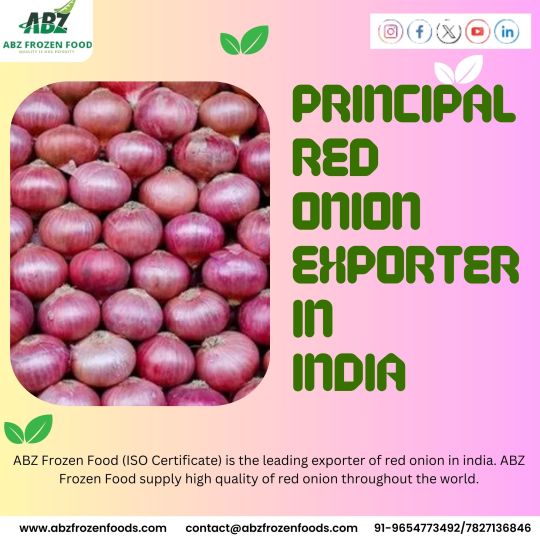
Principal Red Onion Exporter in India
ABZ Frozen Food (ISO Certifited) has established a strong global presence and have a wide network of customers and partners in different countries.Our authentic-grade red onions at ABZ Frozen Foods are sourced from large farms and reputable agriculturists who attest to the genuineness of the product packaging.For more details please call +91-9654773492,7827136846 or visit our website https://abzfrozenfoods.com/red-onion-exporter.html
#Red Onion Exporter#Indian Buffalo Meat#Buffalo Meat Exporter#Buffalo meat exporter from India#Frozen Buffalo meat Exporters in India#Onion Exporter from India#Top Red Onion Exporter in India#Wheat flour Exporter#Yellow Maize Exporter#Green Millet Exporter#Semi Husk Coconut Exporter
0 notes